1988 PONTIAC FIERO light
[x] Cancel search: lightPage 1177 of 1825

Ground Distribution
Figure 8 is a sample Ground Distribution
schematic for the Headlights. It shows exactly
which compcments share each ground. This
information can often be a time-saver when
troubleshooting ground circuits.
For example, if both Headlights and the
ParkITurn Light on one side are all out, you
could suspect an open in their common ground
wire or the ground connection itself. On the
other hand, if one of the lights works, you
know that the ground and the wire up to the
splice are good. You
have learned this just by
inspecting the schematic and knowing the
vehicle's symptoms. No actual work on the
lighting system was needed.
GROUND DlSTRlBUTlON (GI01 AND 6102)
FRONT LIGHTS GROUNDS
LH HlGH BEAM LH - DUAL
BEAM
LIGHT - HEADLIGHT HEADLIGHT RH
- DUAL
BEAM
HEADLIGHT E!! &T HIGH BEAM PARKiTURN HEAilLlGHT 1-
Figure 8 - Typical Ground Distribution Schematic
Page 1178 of 1825
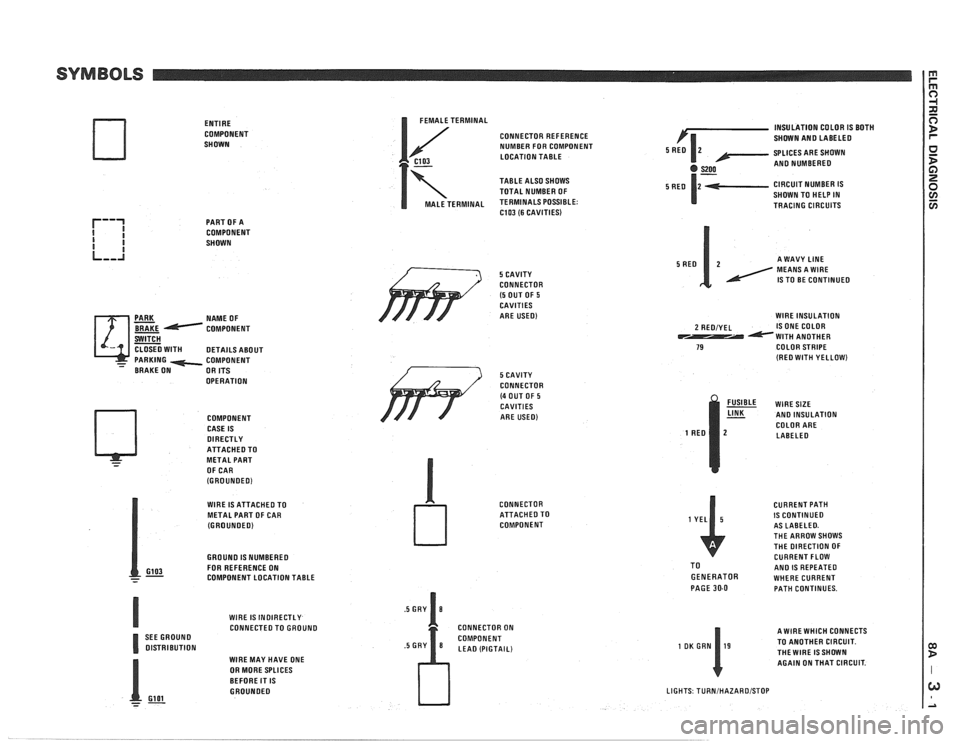
ENTIRE
COMPONENT
SHOWN
PART OF A
COMPONENT
SHOWN
NAME OF
COMPONENT
OPERATION COMPONENT
CASE IS
DIRECTLY ATTACHEOTO
- METAL PART
OF CAR
(GROUNOEO)
I FEMALE TERMINAL
CONNECTOR REFERENCE
NUMBER FOR COMPONENT
C103 LOCATION TABLE
7
TABLE ALSO SHOWS
TOTAL NUMBER OF
MALE TERMINAL TERMINALS POSSIBLE: C103 (6 CAVITIES)
/' 5 CAVITY
CONNECTOR
(5 OUT OF 5 CAVITIES
ARE USED)
WlRE IS ATTACHED TO
METAL PART OF CAR
(GROUNOEO)
GROUNO
IS NUMBEREO
GI03 FOR REFERENCE ON - - - COMPONENT LOCATION TABLE
WlRE
IS INOIRECTLY CONNECTED TO GROUNO
SEE GROUNO
OlSTRlBUTlON WlRE MAY HAVE ONE
OR MORE SPLICES
BEFORE IT
IS GROUNOEO
- Gl 01 --
/ 3 5 CAVITY
CONNECTOR
(4 OUT OF 5 CAVITIES
ARE USED)
CONNECTOR
ATTACHEOTO
COMPONENT
CONNECTOR ON
COMPONENT
LEA0 (PIGTAIL) INSULATION
COLOR
IS BOTH
SHOWN AN0 LABELEO
SPLICES ARE SHOWN
AN0 NUMBEREO
CIRCUIT NUMBER
IS SHOWN TO HELP IN
TRACING CIRCUITS
A WAVY
LINE MEANS A WlRE IS TO BE CONTINUED
WlRE INSULATION
2 REOIYEL IS ONE COLOR WlTH ANOTHER 79 COLOR STRIPE (RE0 WlTH YELLOW)
% WIRESIZE AN0 INSULATION
COLOR ARE
LABELEO
CURRENT PATH
IS CONTINUED
AS LABELEO.
THE ARROW SHOWS
THE DIRECTION OF
CURRENT FLOW
TO
AN0 IS REPEATED GENERATOR WHERE CURRENT
PAGE 30-0 PATH CONTINUES.
A WlRE WHICH CONNECTS
TO ANOTHER CIRCUIT.
THEWIRE ISSHOWN AGAIN ON THAT CIRCUIT.
LIGHTS TURNIHAZAROISTOP
Page 1181 of 1825
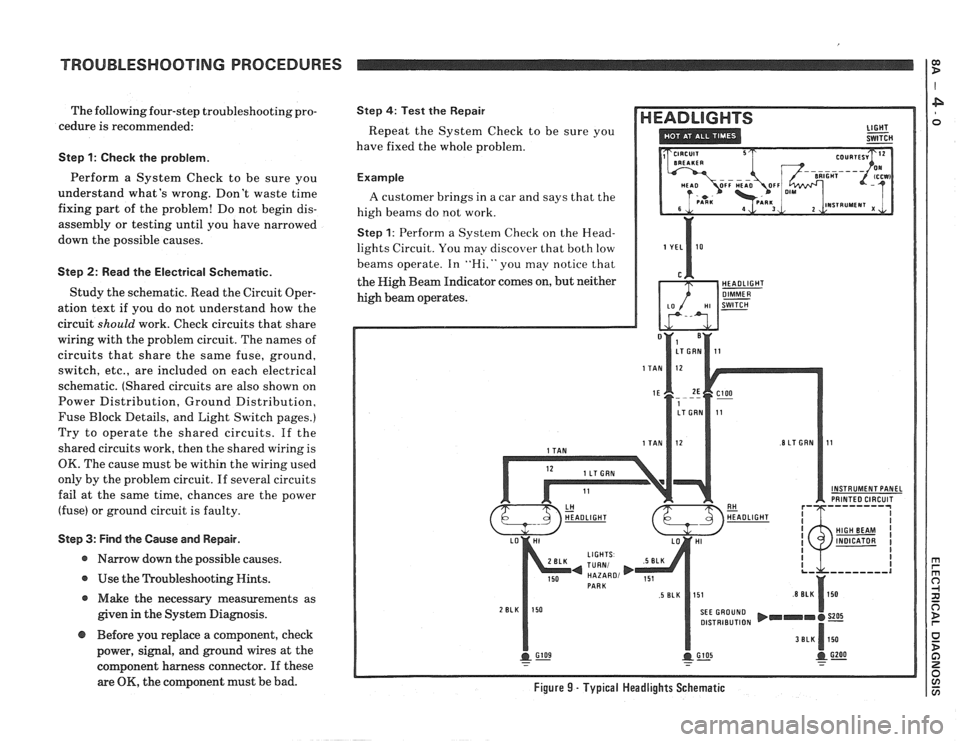
TROUBLESHOOTING PROCEDURES
The following four-step troubleshooting pro-
cedure is recommended:
Step 1: Check the problem.
Perform a System Check to be sure you
understand what's wrong. Don't waste time
fixing part of the problem! Do not begin dis-
assembly or testing until you have narrowed
down the possible causes.
Step 2: Read the Electrical Schematic.
Study the schematic. Read the Circuit Oper-
ation text if you do not understand how the
circuit
should work. Check circuits that share
wiring with the problem circuit. The names of
circuits that share the same fuse, ground,
switch, etc., are included on each electrical
schematic. (Shared circuits are also shown on
Power Distribution, Ground Distribution,
Fuse Block Details, and Light Switch pages.)
Try to operate the shared circuits. If the
shared circuits work, then the shared wiring is
OK. The cause must be within the wiring used
only by the problem circuit. If several circuits
fail at the same time, chances are the power
(fuse) or ground circuit is faulty.
Step 3: Find the Cause and Repair.
* Narrow down the possible causes.
@ Use the Troubleshooting Hints.
@ Make the necessary measurements as
given in the System Diagnosis.
Step 4: Test the Repair
Repeat the System Check to be sure you
have fixed the whole problem.
Example
A customer brings in a car and says that the
high beams do not work.
Step 1: Perform a System Check on the Head-
lights Circuit. You may discover that both low
beams operate. In
"Hi," you may notice that
the High Beam Indicator comes on, but neither
high beam operates.
INSTRUMENT PANEL PRINTED CIRCUIT
DISTRIBUTION
@ Before you replace a component, check
power, signal, and ground wires at the
component harness connector. If these
are
OK, the component must be bad. Figure 9 - Typical Headlights Schematic
Page 1182 of 1825
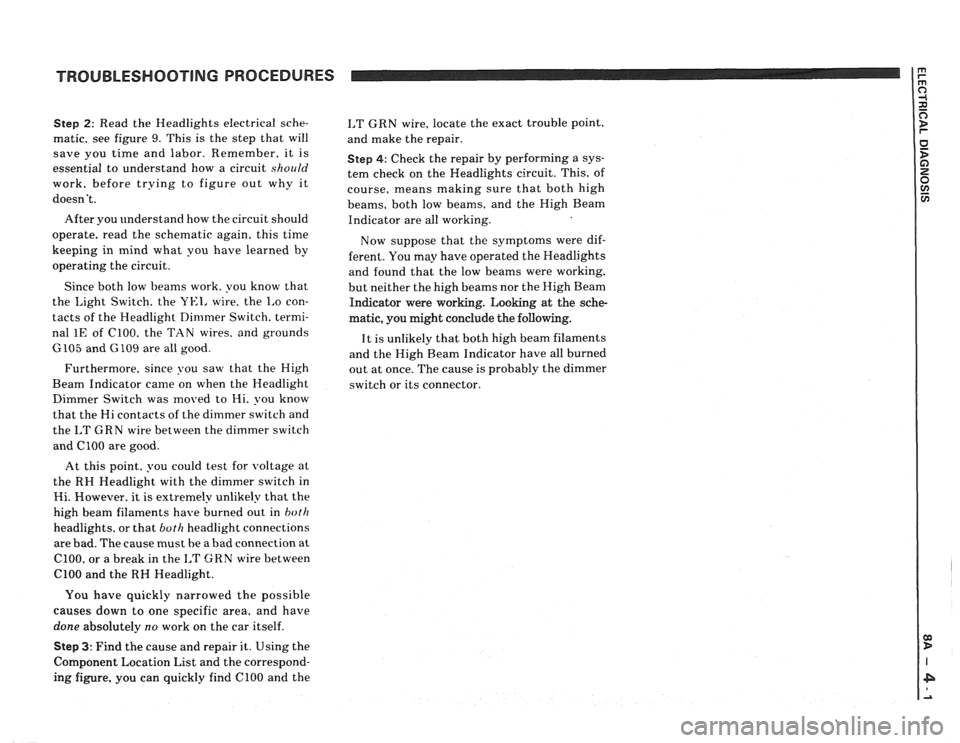
TROUBLESHOOTING PROCEDURES
Step 2: Read the Headlights electrical sche-
matic, see figure
9. This is the step that will
save you time and labor. Remember, it is
essential to understand how a circuit
should
work, before trying to figure out why it
doesn't.
After you understand how the circuit should
operate, read the schematic again, this time
keeping in mind what you have learned by
operating the circuit.
Since both low beams work. you know that
the
Light Switch. the YEI, wire. the I,o con-
tacts of the Headlight Dimmer Switch. termi-
nal
1E of C100. the TAN wires. and grounds
6105 and G 109 are all good.
Furthermore, since you saw that the High
Beam Indicator came on when the Headlight
Dimmer Switch was moved to Hi. you know
that the Hi contacts of the
dimmer switch and
the
I,T GRN wire between the dimmer switch
and ClOO are good.
At this point. you could test for
voltage at
the RH Headlight with the dimmer switch in
Hi. However. it is extremely unlikely that the
high beam filaments have burned out in
both
headlights. or that both headlight connections
are bad. The cause must be a bad connection at
C100, or a break in the I,T GRN wire between
ClOO and the RH Headlight.
I,T GRN wire, locate the exact trouble point,
and make the repair.
Step 4: Check the repair by performing a sys-
tem check on the Headlights circuit. This, of
course, means making sure that both high
beams, both low beams, and the High Beam
Indicator are all working.
Now suppose that the symptoms were dif-
ferent. You may have operated the Headlights
and found that the low beams were working,
but neither the high beams nor the High Beam
Indicator were working. Looking at the sche-
matic, you might conclude the
following.
It is unlikely that both high beam filaments
and the High Beam Indicator have all burned
out at once. The cause is probably the dimmer
switch or its connector.
You have quickly narrowed the possible
causes down to one specific area, and have
done absolutely
no work on the car itself.
Step 3: Find the cause and repair it. Using the
Component Location List and the correspond-
ing figure. you can quickly find ClOO and the
Page 1183 of 1825
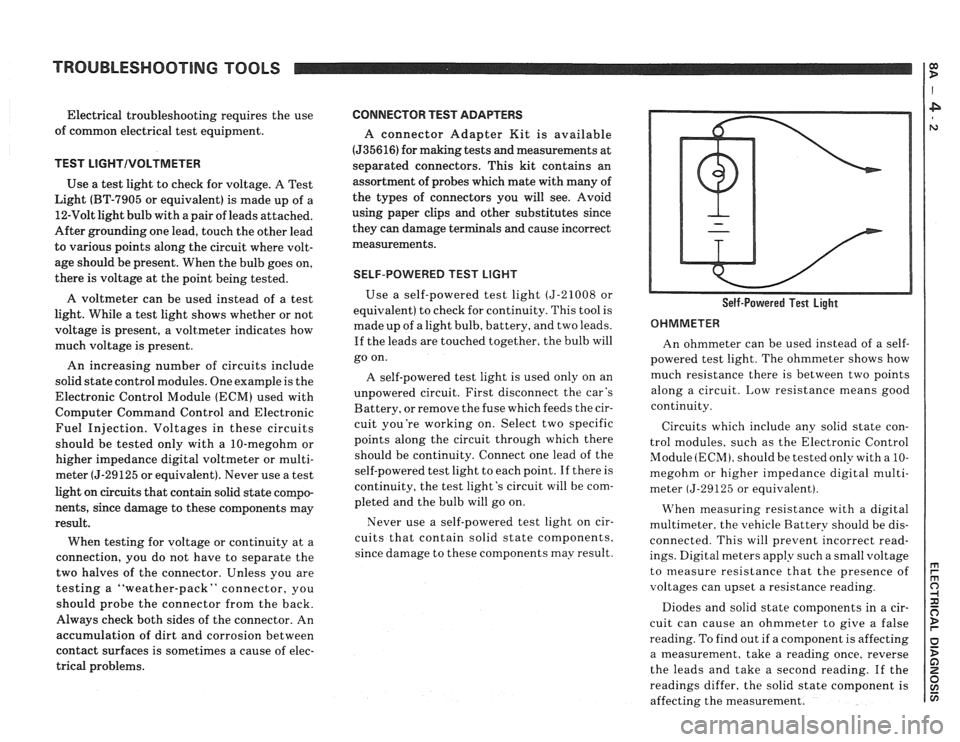
TROUBLESHOOT1NG TOOLS
Electrical troubleshooting requires the use
of common electrical test equipment.
TEST LIGHTIVOLTMETER
Use a test light to check for voltage. A Test
Light (BT-7905 or equivalent) is made up of a
12-Volt light bulb with apair of leads attached.
After grounding one lead, touch the other lead
to various points along the circuit where volt-
age should be present. When the bulb goes on,
there is voltage at the point being tested.
A voltmeter can be used instead of a test
light. While a test light shows whether or not
voltage is present, a voltmeter indicates how
much voltage is present.
An increasing number of circuits include
solid state control modules. One example is the
Electronic Control Module
(ECM) used with
Computer Command Control and Electronic
Fuel Injection. Voltages in these circuits
should be tested only with a 10-megohm or
higher impedance digital voltmeter or multi-
meter (5-29125 or equivalent). Never use a test
light on circuits that contain solid state compo-
nents, since damage to these components may
result.
When testing for voltage or continuity at a
connection, you do not have to separate the
two halves of the connector. Unless you are
testing a "weather-pack" connector, you
should probe the connector from the back.
Always check both sides of the connector. An
accumulation of dirt and corrosion between
contact surfaces is sometimes a cause of elec-
trical problems.
CONNECTOR TEST ADAPTERS
A connector Adapter Kit is available
(535616) for making tests and measurements at
separated connectors. This kit contains an
assortment of probes which mate with many of
the types of connectors you will see. Avoid
using paper clips and other substitutes since
they can damage terminals and cause incorrect
measurements.
SELF-POWERED TEST LIGHT
Use a self-powered test light (5-21008 or
equivalent) to check for continuity. This tool is
made up of a light bulb, battery, and two leads.
If the leads are touched together, the bulb will
go on.
A self-powered test light is used only on an
unpowered circuit. First disconnect the car's
Battery, or remove the fuse which feeds the cir-
cuit you're working on. Select two specific
points along the circuit through which there
should be continuity. Connect one lead of the
self-powered test light to each point. If there is
continuity, the test light's circuit will be com-
pleted and the bulb will go on.
Never use a self-powered test light on cir-
cuits that contain solid state components,
since damage to these components may result. Self-Powered Test Light
OHMMETER
An ohmmeter can be used instead of a self-
powered test light. The ohmmeter shows how
much resistance there is between two points
along a circuit. Low resistance means good
continuity.
Circuits which include any solid state con-
trol modules, such as the Electronic Control
Module
(ECM), should be tested only with a 10-
megohm or higher impedance digital multi-
meter
(5-29125 or equivalent).
VIThen measuring resistance with a digital
multimeter. the vehicle Battery should be dis-
connected. This will prevent incorrect read-
ings. Digital meters apply such a small voltage
to measure resistance that the presence of
voltages can upset a resistance reading.
Diodes and solid state components in a cir-
cuit can cause an ohmmeter to give a false
reading. To find out if a component is affecting
a measurement, take a reading once, reverse
the leads and take a second reading.
If the
readings differ, the solid state component is
affecting the measurement.
Page 1184 of 1825
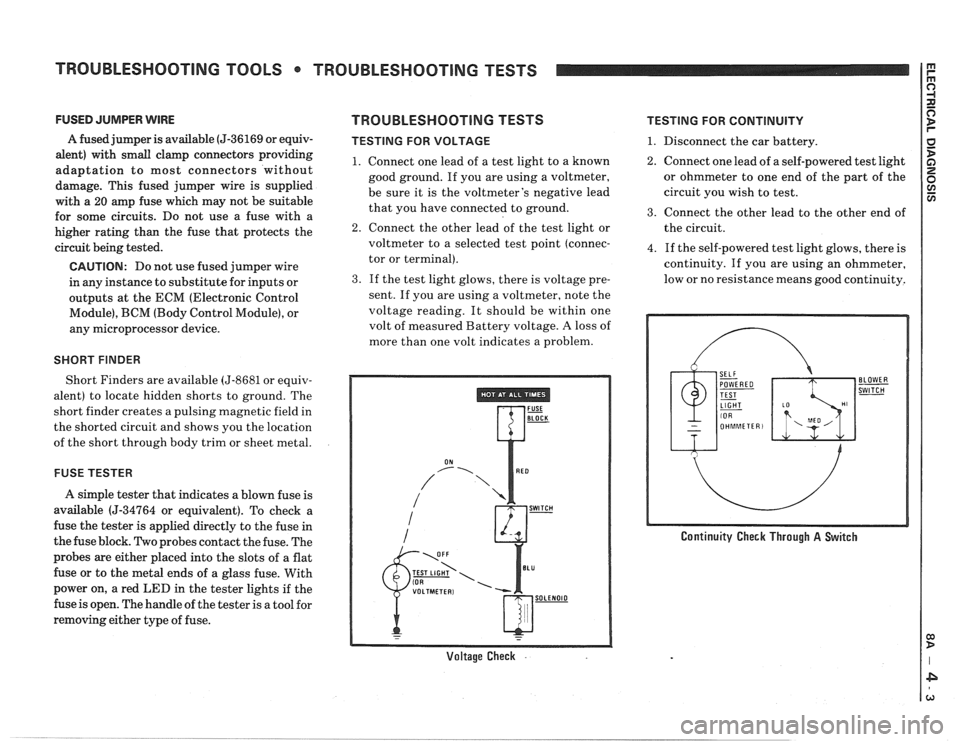
TROUBLESHOOTING TOOLS TROUBLESHOOTING TESTS
FUSED JUMPER WIRE
A fused jumper is available (5-36169 or equiv-
alent) with small clamp connectors providing
adaptation to most connectors without
damage. This fused jumper wire is supplied
with a
20 amp fuse which may not be suitable
for some circuits. Do not use a fuse with a
higher rating than the fuse that protects the
circuit being tested.
CAUTION: Do not use fused jumper wire
in any instance to substitute for inputs or
outputs at the ECM (Electronic Control
Module), BCM (Body Control Module), or
any microprocessor device.
SHORT FINDER
Short Finders are available (5-8681 or equiv-
alent) to locate hidden shorts to ground. The
short finder creates a pulsing magnetic field in
the shorted circuit and shows you the location
of the short through body trim or sheet metal.
FUSE TESTER
A simple tester that indicates a blown fuse is
available (5-34764 or equivalent). To check a
fuse the tester
is applied directly to the fuse in
the fuse block. Two probes contact the fuse. The
probes are either placed into the slots of a flat
fuse or to the metal ends of a glass fuse. With
power on, a red
LED in the tester lights if the
fuse is open. The handle of the tester is a tool for
removing either type of fuse.
TROUBLESHOOTING TESTS
TESTING FOR VOLTAGE
1. Connect one lead of a test light to a known
good ground. If you are using a voltmeter,
be sure it is the voltmeter's negative lead
that you have connected to ground.
2. Connect the other lead of the test light or
voltmeter to a selected test point (connec-
tor or terminal).
3. If the test light glows, there is voltage pre-
sent. If you are using a voltmeter, note the
voltage reading. It should be within one
volt of measured Battery voltage.
A loss of
more than one volt indicates a problem.
Voltage Check .
TESTING FOR CONTINUITY
1. Disconnect the car battery.
2. Connect one lead of a self-powered test light
or ohmmeter to one end of the part of the
circuit you wish to test.
3. Connect the other lead to the other end of
the circuit.
4. If the self-powered test light glows, there is
continuity. If you are using an ohmmeter,
low or no resistance means good continuity.
Continuity Check Through A Switch
Page 1185 of 1825

TROUBLESHOOTING TESTS
TESTING FOR VOLTAGE DROP
This test checks for voltage being lost along
a wire, or through a connection or switch.
1. Connect the positive lead of a voltmeter to
the end of the wire (or to one side of the con-
nection or switch) which
is closer to the Bat-
tery.
2. Connect the negative lead to the other end
of the wire (or the other side of the connec-
tion or switch).
3. Operate the circuit.
4. The voltmeter will show the difference in
voltage between the two points.
A dif-
ference (or drop) of more than one volt indi-
cates a problem.
Voltage Drop Test
TESTING FOR SHORT TO GROUND
With
a Test Light or Voltmeter
1. Remove the blown fuse and disconnect the
load.
2. Connect a test light or voltmeter across the
fuse terminals (be sure that the fuse is
powered).
3. Beginning near the fuse block, wiggle the
harness from side to side. Continue this at
convenient points (about
6 inches apart)
while watching the test light or voltmeter.
4. When the test light glows, or the \voltmeter
registers. there is a short to ground in the
wiring near that point.
Testing For Short With Test Light
or Voltmeter
With a Self-Powered Test Light or Ohmmeter
1. Remove the blown fuse and disconnect the
battery and load.
2. Connect one lead of a self-powered test light
or ohmmeter to the fuse terminal on the
load side.
3. Connect the other lead to a known good
ground.
4. Beginning near the fuse block, wiggle the
harness from side to side. Continue
this at
convenient points (about
6 inches apart)
while watching the self-powered test light or
ohmmeter.
,5. M'hen the self-powered test light glows, or
the ohmmeter registers. there is a short to
ground in the wiring near that point.
SELF POWERED
DISCONNECTED
Testing For Short With Self-Powered
Test Light or Ohmmeter
Page 1186 of 1825
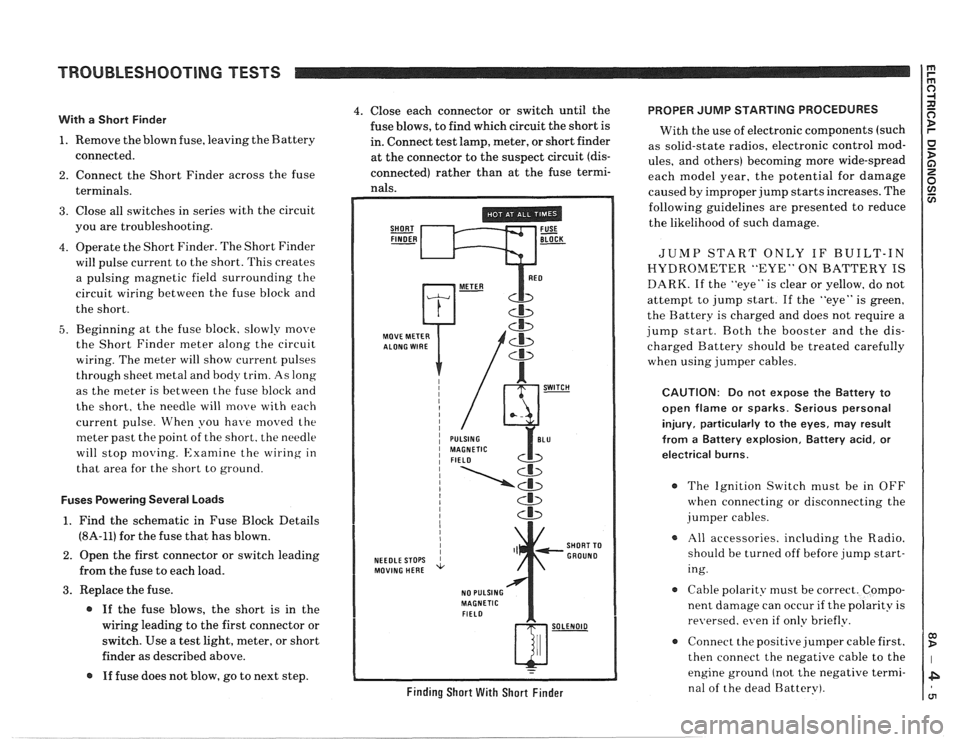
TROUBLESHOOTING TESTS m r rn 0
With a Short Finder
1. Remove the blown fuse, leaving the Battery
connected.
2. Connect the Short Finder across the fuse
terminals.
3. Close all switches in series with the circuit
you are troubleshooting.
4. Operate the Short Finder. The Short Finder
will pulse current to the short. This creates
a pulsing magnetic field surrounding the
circuit wiring between the fuse block and
the short.
5. Beginning at the fuse block. slowly move
the Short Finder meter along the circuit
wiring. The meter will show current pulses
through sheet
inetal and body trim. As long
as the meter is between the fuse block and
the short, the needle will move with each
current pulse. When you have
moved the
meter past the point of the short. the needle
will stop
moving. Examine the wiring in
that area for the short to ground.
Fuses Powering Several Loads
1. Find the schematic in Fuse Block Details
(8A-11) for the fuse that has blown.
2. Open the first connector or switch leading
from the fuse to each load.
3. Replace the fuse.
@ If the fuse blows, the short is in the
wiring leading to the first connector or
switch. Use a test light, meter, or short
finder as described above.
@ If fuse does not blow, go to next step.
4. Close each connector or switch until the PROPER JUMP STARTING PROCEDURES
fuse blows, to find which circuit the short is
With the use of electronic components (such
in. Connect test lamp, meter, or short finder
as solid-state radios, electronic control
mod- at the connector to the suspect circuit (dis- ules, and others) becoming more wide-spread
connected) rather than at the fuse termi- each model year, the potential for damage nals. caused by improper jump starts increases. The
SHORT FUSE FINDER - BLOCK -
MOVE METER
NEEDLE STOPS
MOVING HERE
NO PULSING
MAGNETIC
FIELD
Cb
SHORT TO
GROUND
w-
Finding Short With Short Finder
following guidelines are presented to reduce
the likelihood of such damage.
JUMP START ONLY IF BUILT-IN
HYDROMETER "EYE" ON BATTERY IS
DARK. If the "eye" is clear or yellow, do not
attempt to jump start. If the "eye" is green,
the Battery is charged and does not require a
jump start. Both the booster and the dis-
charged Battery should be treated carefully
when using jumper cables.
CAUTION: Do not expose the Battery to
open flame or sparks. Serious personal
injury, particularly
to the eyes, may result
from
a Battery explosion, Battery acid, or
electrical burns.
The Ignition Switch must be in OFF
when connecting or disconnecting the
jumper cables.
All accessories. including the Radio.
should be turned off before jump start-
ing.
Cable polarity must be correct. Compo-
nent damage can occur
if the polarity is
re~~ersed. even if only briefly.
a Connect the positive jumper cable first.
then connect the negative cable to the
engine ground (not the negative termi-
nal of the dead Battery).